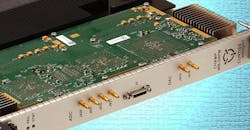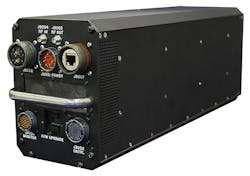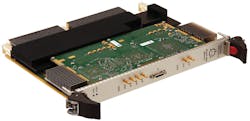Download this article as a .PDF
Radar technology is an effective means of locating distant targets. But radar systems can also be fooled. That is one of the purposes of a digital RF memory (DRFM): to digitize signals that a receiver has captured from an adversary’s radar transmitter so that those signals can be modified and transmitted back the way they came to change the apparent characteristics of the target represented by those signals.
Changes in phase, amplitude, and delay can change the speed, size, and location of a target as an adversary’s radar perceives it. By duplicating return signals, even the number of apparent targets can be increased. The DRFM is a very specialized component but, in the world of electronic countermeasures (ECM), there are few components more important.
A DRFM is a key component in an ECM system or in an electronic-warfare (EW) jammer for its ability to digitize received signals and make precise changes to those signals for retransmission. As an example, changes can be made to a received radar signal’s Doppler characteristics, thus providing an adversary with a false reading on a troop’s location. As with many components for the battlefield, a growing demand is for smaller, lighter DRFMs that can be used not only on aircraft and terrain vehicles, but for remote use in unmanned aerial vehicles (UAVs).
DRFMs are also useful for performing different types of signal jamming, sending back replicas of signals to degrade the performance of their radar receivers. A high-performance DRFM allows accurate, high-resolution control of an input signal, so that adjustments in phase, amplitude, and delay can be made on radar returns, altering such parameters as the location and radar cross section (RCS) as detected by an adversary.
To perform such tasks, a DRFM must be capable of digitizing a received signal with adequate accuracy and bit resolution and store a coherent copy of the received signal in digital memory. The bit resolution of a DRFM’s digitizing components, such as an analog-to-digital converter (ADC), must be high enough to represent the different characteristics of a pulsed radar signal, including leading and trailing edges.
The amount of digital memory must be sufficient to replicate the signal as needed for retransmission as a jammer or false radar return. By having additional control over pulse Doppler shift and delay time, a DRFM can alter the effective location being detected by an adversary’s radar system. The same capabilities make it possible for a DRFM to serve as part of the development platform for a new radar system, such as a hardware-in-the-loop simulator.
To generate the false radar returns that will be transmitted to jam or disrupt an adversary’s radar system, a DRRF typically employs a digital-to-analog converter (DAC) as baseband signal source and then some means of upconverting those baseband signals to the frequency range of interest—notably, the frequency range of the input signals. An upconverting frequency mixer and local oscillator are often used for the frequency translation in order to maintain any artifacts that may have been received with the incoming signals.
Of course, a frequency mixer and other frequency translation components will typically add signal artifacts of their own, but efforts are made to minimize these artifacts in order to prevent detection by an adversary’s radar system. Still, many DRFMs are moving to a more-or-less all-digital architecture, with frequency translation performed in terms of DSP methods and radar returns generated by a high-speed DAC.
Due to the complexity and number of electronic functions required, DRFMs have traditional been relatively large subsystems, typically contained within a large printed-circuit board (PCB) or an enclosed module. In some cases, they can be larger when they must handle environments with severe shock and vibration, such as in avionics applications.
One example is the ruggedized systems developed by Mercury Systems. These robust DRFMs (Fig. 1) are actually full-featured subsystems with multiple circuit boards, dedicated power supplies, and functionality to support long operating lifetimes, such as forced-air cooling. Weighing in at less than 13 lb., these modules measure just 4.75 × 6.25 × 12 in., but that size buys a tremendous amount of capability.
These DRFMs are available to cover 1200-MHz instantaneous bandwidths at S- and X-band frequencies. They cover an input power range of −55 to +10 dBm with as much as 12 b quantization while operating with low noise floor, typically −60 dBc. These DRFM subsystems can process pulse widths from 20 ns to C with range resolution of better than 4.4 ns, and feature a Doppler range of ±300 kHz with better than 20 kHz Doppler resolution. For its functionality, this is actually a compact system, and one example of Mercury Systems’ large lineup of DRFMs. The company offers DRFMs with quantization from 1 to 12 b and in a variety of package sizes, from single-board units small enough for operation in UAVs to full-sized, rack-mount systems for test laboratories.
Deciding on a DRFM
This variety of mechanical designs is common among DRFM suppliers and is an indication of the wide range of applications for DRFMs in defense and even commercial electronic systems. Comparing and evaluating the performance levels of different DRFMs is a matter of understanding how the key specifications contribute to system-level performance. Three of the main DRFM performance parameters are instantaneous bandwidth, input power range, and quantization resolution. The mechanical size of a DRFM design will determine whether it is suitable for avionics applications or better left on the ground, such as in the test laboratory. The three main performance parameters will determine the types of radar returns that can be processed. Another important specification is the sampling rate, since this will determine the frequency range of signals that can be regenerated with a DRFM.
In addition, waveform memory is a critical DRFM performance parameter, since the amount of memory determines the length of waveform that can be digitized for analysis. Some DRFM suppliers may specify memory in terms of standard memory size, such as gigaBytes, while others may provide details about the memory in terms of the amount of waveform time that can be recorded.
How do these different specifications translate into DRFM performance? The requirements for a particular application will depend on the type of waveform to be quantized, the amount of detail that must be known about the waveform, and the required accuracy and resolution of a modified waveform to be generated based on the captured waveform. DRFMs designed for simple waveform recognition tasks can be implemented with 1 or 2 b resolution, while greater detail requires higher bit resolution. The tradeoff is in power consumption. A portable application such as signal identification and recognition in a UAV may require only low bit resolution, but will also benefit from the low power requirements.
As an example of a higher-resolution unit, the Electronic Products Div. of Kratos/CTI offers a board-level DRFM with instantaneous bandwidth of 900 MHz (Fig. 2). It digitizes input signals across a better than 47-dB spurious-free dynamic range at sampling rates to 2.2 GHz. It also digitizes input signals with a 10-b analog-to-digital converter (ADC) and recreates analog radar returns with a 12-b digital-to-analog converter (DAC).
This DRFM allows multiple returns per Doppler channel to accurately simulate another Doppler radar’s returns and provides better than 0.5-ns delay resolution for fine control of pulse returns. It can be equipped with as much as 200 ms of waveform memory, and is supplied in a VME module format for ease of integration into larger systems, such as ECM, EW, and signal-intelligence (SIGINT) systems.
A modular approach was also used in the design of the CHAMP-WB-DRFM DRFM from Curtiss-Wright (www.curtisswright.com). Based on the modular VPX format (Fig. 3), it features a 6-GHz bandwidth and sampling rates to 12 GSamples/s, employed for an 8-b ADC and a 10-b DAC, supported by 8 GB of DDR3L SDRAM waveform memory. The wide bandwidth, high sampling rate, and large waveform memory make this a powerful candidate for DRFM functionality in a variety of systems, including EW, electronic intelligence (ELINT), and SIGINT systems. Additional models are available with higher sampling rates as needed.
Creating Custom Solutions
Due to the specialized nature of DRFM applications, a growing number of DRFM suppliers are developing flexible, adaptable architectures that allow a user to select the amount of functionality and performance needed from a DRFM. For example, the latest member of the Jade family of data converter XMC modules from Pentek is based on the Kintex Ultrascale field-programmable gate array (FPGA) from Xilinx and is generously equipped with high-speed data converters for flexibility.
It includes two 500-MHz-bandwidth analog-to-digital converters (ADCs) with multiband digital downconverters (DDCs), one digital upconverter (DUC), and two 800-MHz-bandwidth 16-b digital-to-analog converters (DACs).
This programmable data converter system supports capture and generation of a 200-MHz bandwidth. While it has performance limits like any DRFM, it also provides a great deal of programming flexibility to allow a user to define their performance requirements for a particular application and the conserve power consumption in the process.
In addition, Mercury Systems has developed its CRFM series of test systems geared to the development of DRFMs. As an example, the CRFM 9041 test system samples at 2.2 Gb/s to capture, store, and replay RF/microwave signals for the development of communications, EW, and radar systems. It allows CW signals to be delayed by as much as 7.5 ms and pulsed signals to be delayed by as much as 15 ms to explore different propagation possibilities.
The CRFM 9041 test system provides an instantaneous bandwidth as wide as 1 GHz across a baseband frequency range of 55 to 1050 MHz (which can be defined as required by a customer), with worst-case spurious level of −45 dBc. The system is highly configurable as a receiver and/or exciter, to capture and generate, respectively, a wide range of signal waveforms for experimentation. The modular test system fits a five-slot, 6U space in a VME chassis. It is supplied with a single-board computer (SBC), power supply, and either a desk-top or rack-mount enclosure.
As with many electronic subsystems, the trend in DRFMs is to provide more capability in smaller packages. Because of the large amount of data conversion, memory, and digital processing required, power consumption is always a concern, along with thermal management as DRFMs are designed into smaller footprints.
With the growing number of more complex signal threats from portable sources, such as UAVs, the need for reliable DRFMs has never been greater. Still, the volumes represented by these applications and the custom natures of DRFMs may never be quite enough to motivate the development of a DRFM on a chip for truly low-power, portable applications.
About the Author
Jack Browne
Technical Contributor
Jack Browne, Technical Contributor, has worked in technical publishing for over 30 years. He managed the content and production of three technical journals while at the American Institute of Physics, including Medical Physics and the Journal of Vacuum Science & Technology. He has been a Publisher and Editor for Penton Media, started the firm’s Wireless Symposium & Exhibition trade show in 1993, and currently serves as Technical Contributor for that company's Microwaves & RF magazine. Browne, who holds a BS in Mathematics from City College of New York and BA degrees in English and Philosophy from Fordham University, is a member of the IEEE.




